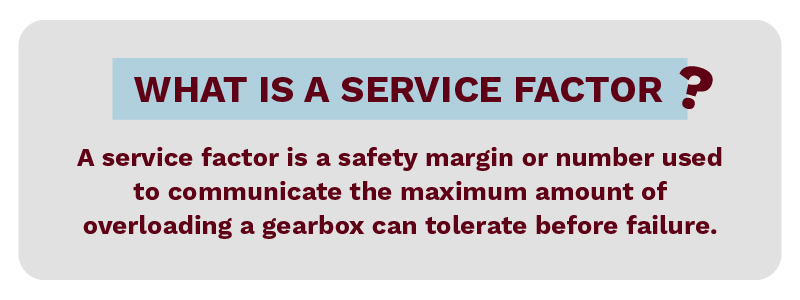Selecting the appropriate gearbox can be challenging, and it’s essential to grasp the importance of service factors. These ratings indicate a gearbox’s ability to reliably handle anticipated loads and conditions. Pick too low, and you risk premature failure. Go too high, and you overpay for an oversized unit.
So, how do you pick a gearbox with the right service factor? Here, we demystify our topic by explaining the importance of service factors to ensure you find the right speed reducer for your specific use.
Gearbox Service Factor: What Is It & Why Is It Important?
What is a Gearbox Service Factor?
A service factor is a safety margin or number The American Gear Manufacturers Association (AGMA) uses to communicate the maximum amount of overloading a gearbox can tolerate before failure.
Manufacturers like Falk use AGMA’s guidelines to assign a service factor rating to a gearbox intended for a specific application.
A higher service factor implies a more conservatively designed gearbox capable of handling greater stresses and load fluctuations. In contrast, a lower ratio has the potential to become easily overloaded if it exceeds its limits.
Conceptually, the idea is to ensure a motor has the appropriate—or additional—power needed to support efficiency, reliability, and safer operating conditions, thereby mitigating damage to equipment and the gearbox itself.
How Do I Find or Calculate My Service Factor?
What is the service factor of a speed reducer? You can usually find a number on the unit or by referencing a manufacturer’s guidelines. If you need help locating the number, reference AGMA’s guidelines or contact a Falk technician for additional assistance.
We generally discourage inexperienced individuals from calculating a gearbox’s service factor because that number is vital to performance and equipment safety. However, if you decide to do it yourself, we encourage you to use AGMA guidelines while considering the following operating conditions that may require increased torque and power:
- Equipment run time and use
- Frequent start/stop cycles
- Load reversals
- Shock loads
- High temperatures or exposure to other elements
- Vibrations
- And added safety needs under some applications
For more help, we encourage you to contact our experts to ensure you receive a gearbox with the appropriate service factor.
6 Reasons Why Gearbox Service Factors Are Important
Using a gear reducer by Falk with the correct service factor allows you to run machinery reliably and withstand challenging conditions while maintaining a reasonable service life—minimizing the risk of premature failure.
Here’s a compilation of reasons from our gearbox motor suppliers highlighting the significance of service factors:
1) It Accounts for Your Application & Operating Conditions
Falk designs gearboxes to operate under specific loading and duty cycle conditions. The service factor helps match the gearbox rating to the application’s demands, ensuring it can withstand the anticipated stresses and loads.
2) It Considers Shock Loads
Many applications involve transient loads, vibrations, or shock loads that are difficult to quantify precisely. The service factor provides an extra margin of safety to account for these unknown or unpredictable loading conditions.
3) It Helps Achieve the Desired Gearbox Life
By properly sizing the gearbox with an appropriate service factor, the gearbox components (gears, bearings, and shafts) can achieve their results without premature failures due to overloading or fatigue.
4) It Avoids Under-Sizing or Over-Sizing
Using too low of a service factor risks under-sizing the gearbox, leading to excessive wear, noise, and potential failures. Conversely, an overly conservative service factor results in an oversized and costly gearbox.
5) It Allows You To Follow Industry Standards
Service factor guidelines from organizations like AGMA are based on decades of experience from gearbox manufacturers across various industries. Following these standards helps ensure reliable gearbox selection and operation.
6) It Helps Optimize Capital and Operating Costs
By correctly matching the gearbox service factor to the application demands, you can avoid over-engineering and purchasing an unnecessarily oversized (and more expensive) gearbox. On the other hand, going with a lower service factor risks premature gearbox failure, which can result in costly downtime, repairs, and frequent replacements.
Premier Falk Gearbox Suppliers Offering Expert Repair & Renewal Services
We encourage you to leverage our expertise in the gearbox industry should you need it. By partnering with us, we’ll ensure you receive a gearbox with the right specs while delivering sustained performance and excellence. View our robust speed reducer and parts inventory.
Connect with a Falk specialist by contacting us online or calling us at 503-468-0454—we’re here to help.







